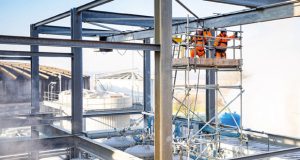SAFE AND SECURE
Rebecca Whitwham, Marketing Manager at Asckey argues that safety and security will also be a focus, for as well as the running of the estate, organisations in every sector need to rethink how they create and maintain a safe, hygienic working environment.
She explains: “For most organisations, this doesn’t mean the extensive level of deep cleaning employed by the NHS & Care sectors but does raise the issue of whether health and safety standards need to go beyond just using the appropriate cleaning materials and chemicals.”
As we move on from the pandemic, Whitwham sees FM departments across all sectors looking for a more sustainable and hybrid way of working. Paper-based checklists, task lists, work orders etc., are starting to transfer to digital options. Digitising these processes provides an online audit trail of accountability and can help organisations demonstrate they are meeting required compliance standards. And while digitising processes provide accessible evidence that compliance standards are met, it also allows for organisations to meet their sustainability goals.
Says Whitwham: “For years CAFM software has been helping the FM industry with more efficient task and asset management. However, we are also seeing it being used as a tool to help organisations meet sustainability objectives. After all, buildings often represent one of the most significant contributors to an organisation’s carbon footprint.
“CAFM software is an incredibly large data resource, managing tasks, assets and everything in between. Not only can it help organisations to evidence that compliance standards are met, but it can also help to effectively manage maintenance tasks that can support and improve an asset’s lifespan. As a result, CAFM software can help reduce waste and remove the need for unnecessary replacements. Well-maintained assets use less energy and therefore have a big impact on meeting sustainability goals.”
DATA POWER
Access to growing amounts of data across numerous functions and purposes is a game changer for FMs says Idox’ Bryan.
“The analysis and insight from that data can provide powerful tools for facilities managers, enabling them to translate that insight into automated processes and work orders which in turn create significant operational savings.
“IoT sensor technology can enhance data analysis further, as assets can communicate their status with no human interaction required. As this technology has rapidly advanced, discrete wireless sensors can now be deployed quickly with minimal configuration and maintenance. Data points such as temperature, space occupancy, sanitiser fill levels, cleaning status, CO2 levels can all be collected and analysed to inform management decisions and future strategy – all empowering FMs with the tools to remotely optimise working environments to suit user needs, keep them safe and compliant.”
The use of data extends beyond office spaces says Bullard, as the way other industries work, such as healthcare or leisure facilities, can adopt a digital audit trail that tracks what has been done and when.
“Adaptability has become a key focus and teams need to move quickly should working scenarios change again,” he advises. “And of course, facilities managers themselves are now able to do much of their management remotely too. They can interrogate their Building Management System from their device at home, immediately understand what’s going on – heating levels, lift operation, asset issues – and get them resolved whilst retaining reduced capacity.
“The entire facilities management operation has become more accessible to the entire business, and the priority of these teams and technology in providing a continued experience for employees has increased exponentially.”
Whitwham believes the benefits of a CAFM system’s reports are in not only reflecting key performance indicators and productivity levels but in producing financial reports that demonstrate a department’s output.
“From buildings and services to equipment and personnel, CAFM software connects all aspects of facilities management. It provides organisations with the key information needed to make better informed and more cost-effective operational decisions.”
Bryan points out that when it comes to asset life cycles, certain assets will require more servicing attention than others to maintain optimum performance. He believes Planned Preventative Maintenance (PPM) via a CAFM system can support this analysis, identifying which assets are working smoothly and don’t require servicing (and those that do), thereby helping to reduce the level of reactive maintenance jobs and freeing up FMs for more valuable tasks. In addition, as jobs can be logged faster with real-time status updates, efficiency can be significantly increased. Benchmarking of performance can also track the results and impact of changes to continually evolve and improve processes.
THE FUTURE
“The pandemic proved to be a catalyst for technology investment, but in many ways this rollout of technology was overdue,” says Bryan. “Although restrictions may be easing, government guidance and the business landscape can change rapidly – organisations must be prepared for the next challenge. In order to future-proof businesses as much as possible, investment into the right technology, tools and skills is critical to foster resilience, agility and continuity.”
Miller sees the future in two parts. “First, more businesses require simple, easy-to-use CAFM, starting their digital transformation, enabling them to manage maintenance and compliance while reducing operational costs of each location. Then as their digital transformation journey progresses businesses will start to capture rich data on their building usage now and in the future to support strategic decision making.
“The second will be the adoption of IoT and sensor technology to improve the user experience in the workplace. By monitoring areas like air quality, energy usage, occupancy levels and M&E equipment, a business is able to provide the best working environment for its employees enabling them to attract and retain the very best talent.”
Looking ahead, Bullard says the next big positive disruption is set to come from AI, bringing an even deeper level of data insight and understanding. “The relationship between facilities management and technology is only set to intertwine further, making the future of the industry an exciting prospect for us all.”






